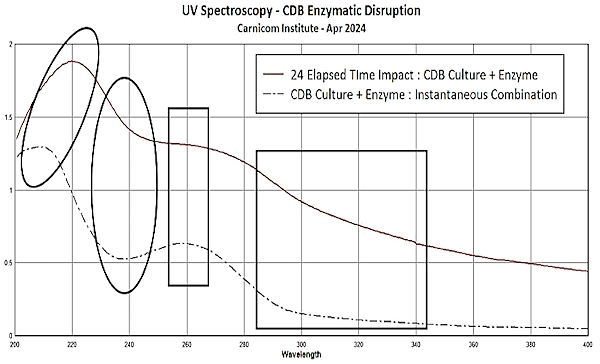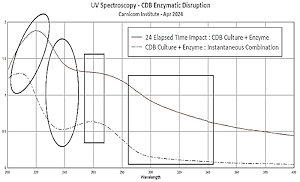Disruption (I & II)
Clifford E Carnicom
Apr 23 2024
Edited May 31 2024
A measure of success has been achieved at disrupting the early stage growth of the Cross Domain Bacteria (CDB, nomenclature, 2014), a genetically engineered, xenobiotic, synthetic biology life form under study by Carnicom Institute (CI). The harm from this biology upon humans (and upon life in general) has ample discussion within the CI site and will not be repeated here. The expected relationships of this synthetic biology, with an origin of decades past, to the additional harm from the “Covid Era” are also no stranger here. The repetition of threat to human existence has passed its prime, and we shall all choose our direction.
The method adopted is one of enzymatic disruption, and it has its origin within CI research some time ago. It has been stated on more than one occasion and in more than one year that a likely fruitful course of action to thwart harm is to disrupt protein growth at the onset. Ideally , this is to be done at the origin of the problem, and not at the tail end. Attempting to remove synthetic polymers (ergo, blood clotting) from the human body after they are already in place is a last resort that speaks of desperation. That is another real problem ahead…
Proteins are the stuff of structure of biology, and the target is their ORIGIN and creation, not their product. Synthetic biology is no exception, and it too is destined to make proteins.

Ultraviolet (UV) Spectrum of Early Stage CDB Culture
Subject to Enyzmatic Disruption
It has taken some effort to piece together the mechanisms that are at play in developing what is admittedly still a coarse understanding of the CDB metabolism. The framework of this understanding is organic chemistry, I suspect most all of it self-taught over the years. However strange and unimaginable our world has become over recent decades, the laws of nature always rule the roost. That will never change. There are many ways to approach a problem and they may each have their benefits to bring. One of these happens to be, even with synthetic biology at hand, the steadfast study and science of organic chemistry. Many have done hard work before us, and it is best not to forsake their efforts, and we best learn from the discoveries and sacrifices already made.
I will not go into great detail at this stage, other than make a few general comments of fact.
There remains infinite work ahead, as time permits, and any and all CI information must be viewed as preparatory only.
___________End of Summary____________
_________________________________________
Let us look at why we know a certain level of success in disruption is in place. Ultraviolet spectroscopy is actually a rather generalized form of the science, and does not offer, by itself, detailed structural information. But it is quite valuable at gaining insight into the big picture at hand. A change in a UV spectral profile is a good sign that something major is happening where (and when in this case also) it needs to happen, and this is at the molecular level on a grander scale.
There are four regions of marked change in the absorbance of ultraviolet energy that demonstrate enzymatic disruption to the CDB. These are marked on the plot, and include variation in the locations or regions :
1. 210-220 nm .
2. 236 nm.
3. 260 nm.
4. 285-400 nm.
An investigation into UV absorbance change in this region will lead to the following assessment:
1. Significant conformational (i.e., molecular structure) change is almost certainly taking place as a result of the enzymatic activity, most likely involving proteins, DNA or both.
2. Amino acids are likely being broken down into smaller fragments and peptide (i.e., protein) bonds of the CDB (i.e, synthetic biology) are being broken.
3. Enzymatic activity is likely disrupting hydrogen bonds of the DNA, if it is present (previous work confirms the existence of CDB DNA).
4. If nucleotides are present in the culture, they too are likely being disrupted.
5. The overall energy state of the CDB culture is likely being decreased.
6. In general, these changes can be interpreted to be to the detriment of the CDB (i.e., synthetic biology known to cause grievous harm to human health) existence and metabolism.
This result, therefore, sets the stage for additional significant CDB mitigation (or termination) work in the future. There are scores of mitigation (or termination) strategies already inherent in the published and library work, should it be examined properly.
All CI work is to serve the public interest and welfare at all times. Carnicom Institute will require that certain and further advanced discretionary disclosures, should they occur on this and related work, are directed to serve the public welfare and non-profit motives. The rights of public and affordable access to all benefits that may ensue are inherent. Interested parties, operating at the directorate or managerial level of such organizations or effort, are welcome to contact Carnicom Institute [info@carnicominstute.org]. A history of charitable public service (in any and all professions) is paramount in any consideration. Any coordination should be viewed in terms of planning prospects only.
It is recommended that additional work of CI be reviewed to understand the scope and historic context of this paper.
___________
Edit May 31 2024:
Additional disruptive strategies to the CDB metabolism have been established. The additional methods derive from laboratory study and findings, and they evolve from organic chemistry analysis and the extensive use of Raman spectroscopy. The disruption to the CDB metabolism and metabolic products is more specific at this stage, and it is likely to provide benefit within such topics as:
1. CDB molecular structural alteration
2. cellular membrane fluidity
3. reduction of CDB metabolic products
4. Reduction of CDB protein development
The analytical results obtained are further supported by application and observation.
The following statements are repeated, and they are relevant to all contemporary research:
___________
1. It is best to attack a problem at its origin.
2. “All CI work is to serve the public interest and welfare at all times. Carnicom Institute will require that certain and further advanced discretionary disclosures, should they occur on this and related work, are directed to serve the public welfare and non-profit motives. The rights of public and affordable access to all benefits that may ensue are inherent. Interested parties, operating at the directorate or managerial level of such organizations or effort, are welcome to contact Carnicom Institute [info@carnicominstute.org]. A history of charitable public service (in any and all professions) is paramount in any consideration. Any coordination should be viewed in terms of planning prospects only.”
If you would like to assist in the accelerated transfer of additional laboratory accomplishment to the general public and professional communities, please consider doing exactly as is requested above. Please make an effort to put charitable organizations that meet the criteria above in contact with Carnicom Institute. In addition, please download the additional resources that are available at the CI Library portal. Thank you.”
Note: STATUS AS OF MAY 31 2024: INQUIRIES : 0.
Additional note: Communication blockage is now active.
Alternate email address: carnicominstitute@protonmail.com
Mail: Carnicom Institute PO Box 105 Alberton MT 59820
___________
Sincerely,
Clifford E Carnicom
Apr 23, 2024
Edited May 31 2024
born Clifford Bruce Stewart
Jan 19 1953




